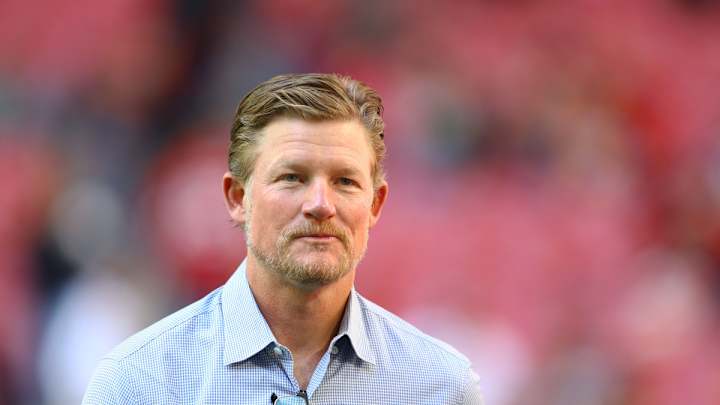Why Rams are comfortable operating in salary cap jail

With the salary cap set at $182.5 million and the Los Angeles Rams carrying over $4.6 million from last year, L.A. remains roughly $31 million over an adjusted salary cap of $187.1 million for the start of the new league year on March 17.
At this juncture, the Rams have the largest deficit in the NFL to get under the salary cap by next week.
So, Rams GM Les Snead, COO Kevin Demoff, salary cap specialist Tony Pastoors and the rest of personnel department will have some tough decisions to make.
That includes having conversations with players on their second or third contracts like Aaron Donald, Jalen Ramsey, Andrew Whitworth, Robert Woods, Cooper Kupp, Michael Brockers and Rob Havenstein to restructure deals.
Snead said his team’s No. 1 goal is to get under the salary cap so that they can sign some of their own free agents set to hit free agency next week.
“We’ve had to knock on the door of a lot of our key figures and key pillars and ask them in some cases to make sacrifices, and some cases adjust their contract to help us get under the cap,” Snead said. “The vision right now is to get to the finish line without having to release players.”
Along with that, Snead said the Rams had conversations with pending restricted and unrestricted free agents, letting them know if they will attempt to resign them or let them hit free agency to establish their value in the open market.
The Rams chose not to use the franchise tag this season. The last time the Rams used the franchise tag was in 2018 on safety LaMarcus Joyner.
“You’ve got to have cap room to use the franchise tag, that’s No. 1,” Snead said. “Strategically and probably philosophically, you’d love to not have to use the franchise tag, and work to get something done long-term just because usually when there’s a franchise tag and you use it, just the history of it says it’s very hard to get something done longer term off that tag.”
The Rams have 10 unrestricted free agents, including co-captain and defensive play caller safety John Johnson III, edge rusher Leonard Floyd, receiver Josh Reynolds, tight end Gerald Everett and center Austin Blythe.
Snead said the Rams managing salary cap constraints is nothing new. It’s part of the way the team has chose to do business over the past few years to remain competitive and keep the team’s Super Bowl window open, using draft capital to trade for proven commodities and taking risks to sign players to lucrative deals, with mixed results.
The Rams received good return on their investment in players like Donald, Ramsey and Whitworth, but also have had to deal with significant dead salary cap money in moving on from players like Todd Gurley, Brandin Cooks and most recently Jared Goff.
What the Rams have tried to do is use first-round draft capital to secure proven veteran players like Cooks, Ramsey and Matthew Stafford, and then be disciplined on the compensatory pick formula and mid-to-late round draft selection, developing and using young players to replace experienced players lost in free agency.
While the Rams have not taken a player in the first round since 2016, Snead said they’ve had the eighth-most draft picks overall in the NFL since that year, the third-most Day 2 (second and third-round picks) and sixth in Day 3 selections (fourth through seventh round) over that time frame.
The NFL announced on Wednesday the Rams have three compensatory selections in this year’s draft, two in the third round and one in the fourth round. That brings the Rams total of selections in this year’s draft to six – with of course no first round pick because they traded it away for Stafford.
“That’s kind of the model, the method to the madness,” Snead said. “And what that does take is discipline. And I can’t stress this enough; it takes a special coaching staff, and they matter. Not only in partnering with our front office but partnering with our scouting staff to help identify players. … And to have the courage to play young players.”
Snead pointed to players like Sebastian Joseph-Day, Troy Hill, Troy Reeder, Van Jefferson, Xavier Jones and Tremayne Anchrum Jr. as examples of young players secured and developed through this system that have and will make impacts for the Rams.
“I don’t think there’s anything that we’re really doing differently here, other than the fact that we have determined that it might be beneficial to use some of our late first-round picks -- and even bet that we’re going to have some later first-round picks in the future -- to get known commodities instead of rookies,” Snead said.
Unrestricted free agents (10): RB Malcolm Brown, C Austin Blythe, OLB Samson Ebukam, TE Gerald Everett, DE Morgan Fox, CB Troy Hill, S John Johnson, LS Jake McQuaide, WR Josh Reynolds, OLB Derek Rivers.
Restricted Free Agents (2): CB Darious Williams, TE Johnny Mundt.
Exclusive rights tendered (2): C-G Coleman Shelton, LB Travin Howard.
Futures contracts signed: (16): QB Devlin Hodges, LB Derreick Moncrief, S Jake Gervase, DT Eric Banks, DT Marquise Copeland, TE Kendall Blanton, DB Donte Deayon, DB Tyrique McGhee, OL Jamil Demby, LS Colin Holba, WR J.J. Koski, K Austin MacGinnis, QB Bryce Perkins, LB Christian Rozeboom, DL Jonah Williams, P Brandon Wright.

Eric D. Williams covers the Rams for Sports Illustrated. He worked for seven seasons covering the Los Angeles Chargers for ESPN.com, and before that served as the beat reporter covering the Seattle Seahawks for the Tacoma News Tribune.